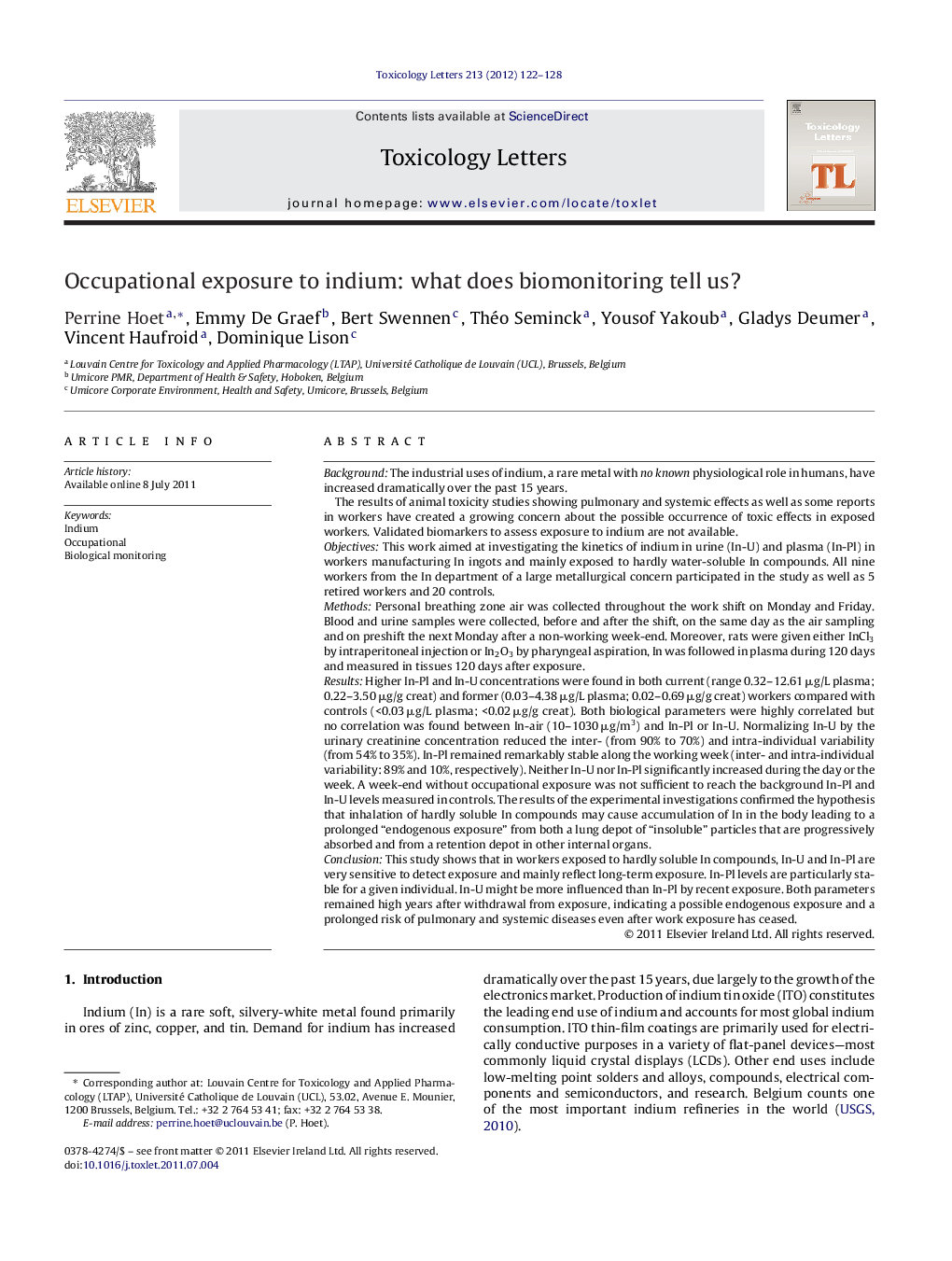| کد مقاله | کد نشریه | سال انتشار | مقاله انگلیسی | نسخه تمام متن |
|---|---|---|---|---|
| 2599492 | 1133210 | 2012 | 7 صفحه PDF | دانلود رایگان |

BackgroundThe industrial uses of indium, a rare metal with no known physiological role in humans, have increased dramatically over the past 15 years.The results of animal toxicity studies showing pulmonary and systemic effects as well as some reports in workers have created a growing concern about the possible occurrence of toxic effects in exposed workers. Validated biomarkers to assess exposure to indium are not available.ObjectivesThis work aimed at investigating the kinetics of indium in urine (In-U) and plasma (In-Pl) in workers manufacturing In ingots and mainly exposed to hardly water-soluble In compounds. All nine workers from the In department of a large metallurgical concern participated in the study as well as 5 retired workers and 20 controls.MethodsPersonal breathing zone air was collected throughout the work shift on Monday and Friday. Blood and urine samples were collected, before and after the shift, on the same day as the air sampling and on preshift the next Monday after a non-working week-end. Moreover, rats were given either InCl3 by intraperitoneal injection or In2O3 by pharyngeal aspiration, In was followed in plasma during 120 days and measured in tissues 120 days after exposure.ResultsHigher In-Pl and In-U concentrations were found in both current (range 0.32–12.61 μg/L plasma; 0.22–3.50 μg/g creat) and former (0.03–4.38 μg/L plasma; 0.02–0.69 μg/g creat) workers compared with controls (<0.03 μg/L plasma; <0.02 μg/g creat). Both biological parameters were highly correlated but no correlation was found between In-air (10–1030 μg/m3) and In-Pl or In-U. Normalizing In-U by the urinary creatinine concentration reduced the inter- (from 90% to 70%) and intra-individual variability (from 54% to 35%). In-Pl remained remarkably stable along the working week (inter- and intra-individual variability: 89% and 10%, respectively). Neither In-U nor In-Pl significantly increased during the day or the week. A week-end without occupational exposure was not sufficient to reach the background In-Pl and In-U levels measured in controls. The results of the experimental investigations confirmed the hypothesis that inhalation of hardly soluble In compounds may cause accumulation of In in the body leading to a prolonged “endogenous exposure” from both a lung depot of “insoluble” particles that are progressively absorbed and from a retention depot in other internal organs.ConclusionThis study shows that in workers exposed to hardly soluble In compounds, In-U and In-Pl are very sensitive to detect exposure and mainly reflect long-term exposure. In-Pl levels are particularly stable for a given individual. In-U might be more influenced than In-Pl by recent exposure. Both parameters remained high years after withdrawal from exposure, indicating a possible endogenous exposure and a prolonged risk of pulmonary and systemic diseases even after work exposure has ceased.
► We investigated the kinetics of In in workers exposed to poorly soluble In compounds.
► In-U and In-Pl are very sensitive to detect exposure to such compounds.
► Both parameters are particularly stable.
► Both parameters may remain high years after withdrawal from exposure.
► Rat studies showed both a lung depot of In particles and retention in internal organs.
Journal: Toxicology Letters - Volume 213, Issue 1, 13 August 2012, Pages 122–128